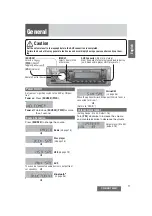
Œ
Clipping Indicator: This yellow LED
indicates when the output signal is at
maximum level before distortion
(clipping) occurs. It will be dimly lit just
before the onset of clipping, and full
bright at clipping. Since the bassRESTOR
can produce up to 10Vrms at maximum
output, it is likely that gain will need to be
reduced below the illumination point to match your amplifier(s) maximum input capability, optimize
source volume range or compensate for bass restoration applied after initial gain setting.
Gain Adjustment: This adjustment is for matching the output signal level of the bassRESTOR with the
maximum unclipped signal provided by your source and the maximum input capability of your
amplifier(s). Follow proper gain setting procedures to ensure optimum source volume range without
clipping at any point in the signal chain. If using music to set system gains, it is recommended to utilize
a variety of bass content and recording levels to ensure proper headroom and minimize the ability to
overdrive the system. Readjustment may be necessary after any changes to other settings.
Ž
Bass Processor: This section provides full adjustment over all parameters of the bass restoration
process as well as a subsonic filter. Unlike traditional equilization, this provides tuning flexibility for
how bass restoration is dynamically applied to music content as well as for differences between
vehicles and subwoofer systems.
Effect: Provides adjustment for the maximum amount of boost that can be applied by the bass
restoration process, which depends upon the music content being played as well as the width and
frequency settings. Effect is essentially a limiter to prevent overdriving subwoofers when set
properly. If gain has already been adjusted, adding more effect may cause the output to clip and
require reduction of gain to achieve final desired unclipped output level. After effect level is set, it
is recommended to only use the remote’s outer ring for on-the-fly bass level adjustments.
Width: This adjustment sets the bandwidth of frequencies enhanced by the bass restoration
process. A wide setting will include more adjacent frequencies for a broad bass enhancement,
while a narrow setting will only add frequencies closer to the chosen center frequency. Note that
changing the width may also require readjustment of the effect and/or gain settings to prevent
clipping or overdriving the system.
‘
Frequency: This adjustment is for setting the center of the frequency range enhanced by the bass
restoration process, between 30Hz and 80Hz.
’
Subsonic: Provides adjustment of the subsonic filter cut-off point (F) below which all frequencies
are filtered out. Very low frequencies can waste amplifier power but this setting is especially
important for preventing damage to subwoofers from large amounts of bass restoration and
potential for over-excursion in ported enclosures below the tuning frequency.
Top Panel Adjustments
Example-3: RCA Input from Aftermarket Radio
+12V
GND
RLC
REM IN
RCA IN
RCA
OUT
REM OUT
4
Note: If the source’s output signal is full-range and the bassRESTOR is being used for subwoofer(s) only, a low-pass filter
will need to be engaged at the amplifier to filter out unwanted higher frequencies. Additionally, unless the amplifier
already has an adequate subsonic filter, set the bassRESTOR’s subsonic filter appropriately to prevent over-excursion.
bassRESTOR
EFFECT
BASS PROCESSOR
80
30
50
MED
NAR
WIDE
MID
MIN
MAX
15
50
30
EFFECT
BASS PROCESSOR
80
30
50
MED
NAR
WIDE
MID
MIN
MAX
15
50
30
Note
:
The bassRESTOR is capable of full-range signal output. When used for a subwoofer system, a low-pass
filter (usually built into amplifiers) will need to be applied and adjusted appropriately to remove
unwanted higher frequencies. If the subsonic and a low-pass filter’s cut-off points are set too closely
together, only a narrow frequency range will pass through and will result in reduced output.


























